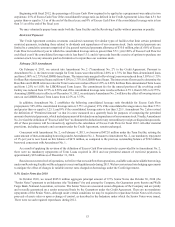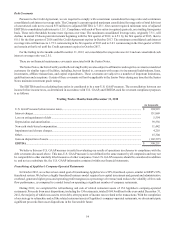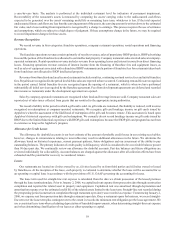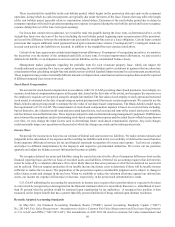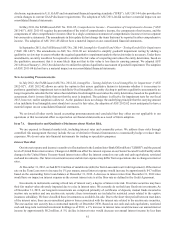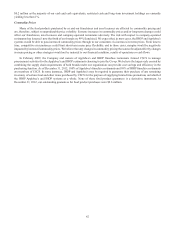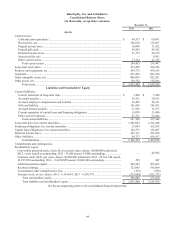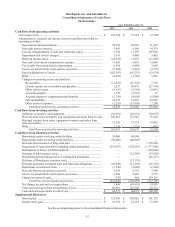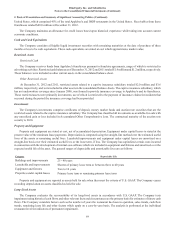IHOP 2012 Annual Report Download - page 79
Download and view the complete annual report
Please find page 79 of the 2012 IHOP annual report below. You can navigate through the pages in the report by either clicking on the pages listed below, or by using the keyword search tool below to find specific information within the annual report.61
disclosure requirements in U.S. GAAP and international financial reporting standards (“IFRS”). ASU 2011-04 also provides for
certain changes in current GAAP disclosure requirements. The adoption of ASU 2011-04 did not have a material impact on our
consolidated financial statements.
In May 2011, the FASB issued ASU No. 2011-05, Comprehensive Income - Presentation of Comprehensive Income (“ASU
2011-05”). ASU 2011-05 requires the presentation of the total of comprehensive income, the components of net income, and the
components of other comprehensive income either in a single continuous statement of comprehensive income or in two separate
but consecutive statements. The amendments in this update did not change the items that must be reported in other comprehensive
income. The adoption of ASU 2011-05 did not have a material impact on our consolidated financial statements.
In September 2011, the FASB issued ASU No. 2011-08, Intangibles-Goodwill and Other - Testing Goodwill for Impairment
("ASU 2011-08"). The amendments in ASU No. 2011-08 are intended to simplify goodwill impairment testing by adding a
qualitative review step to assess whether the required quantitative impairment analysis that exists today is necessary. Under these
amendments, an entity would not be required to calculate the fair value of a reporting unit unless the entity determines, based on
the qualitative assessment, that it is more likely than not that its fair value is less than its carrying amount. We adopted ASU
2011-08 as of January 1, 2012, but did not elect to utilize the option of qualitative assessment of goodwill impairment. The adoption
of ASU 2011-08 did not have a material impact on our consolidated financial statements.
New Accounting Pronouncements
In July 2012, the FASB issued ASU No. 2012-02, Intangibles - Testing Indefinite Lived Intangibles for Impairment (“ASU
2012-02”). ASU 2012-02 allows an entity the option to first assess qualitative factors to determine whether it is necessary to
perform a quantitative impairment test on indefinite-lived intangibles. An entity electing to perform a qualitative assessment is no
longer required to calculate the fair value of an indefinite-lived intangible asset unless the entity determines, based on the qualitative
assessment, that it is more likely than not that the asset is impaired. The guidance is effective for impairment tests for our fiscal
2013, however, earlier adoption is allowed. As the guidance does not change the underlying principle that the carrying amount
of an indefinite-lived intangible asset should not exceed its fair value, the adoption of ASU 2012-02 is not anticipated to have a
material impact on our consolidated financial statements.
We reviewed all other newly issued accounting pronouncements and concluded that they either are not applicable to our
operations or that no material effect is expected on our financial statements as a result of future adoption.
Item 7A. Quantitative and Qualitative Disclosures about Market Risk.
We are exposed to financial market risk, including interest rates and commodity prices. We address these risks through
controlled risk management that may include the use of derivative financial instruments to economically hedge or reduce these
exposures. We do not enter into financial instruments for trading or speculative purposes.
Interest Rate Risk
Our interest expense and income is sensitive to fluctuations in the London Inter-Bank Offered Rate ("LIBOR") and the general
level of United States interest rates. Changes in LIBOR can affect the interest expense on our Senior Secured Credit Facility while
changes in the United States Treasury-based interest rates affect the interest earned on our cash and cash equivalents, restricted
cash and investments. Our future investment income and interest expense may differ from expectations due to changes in interest
rates.
At December 31, 2012, we had $472.0 million of variable rate debt (the Term Loan under our Credit Agreement). If the interest
rate on the Term Loan were to increase by 1% per annum, annual interest expense would increase by approximately $4.7 million
based on the outstanding Term Loan balance at December 31, 2012. A decrease in interest rates from December 31, 2012 rates
would have no impact on interest expense as the current interest rate is at the floor rate as defined in the Credit Agreement.
Investments in instruments earning a fixed rate of interest carry a degree of interest rate risk. Fixed rate securities may have
their fair market value adversely impacted due to a rise in interest rates. We currently do not hold any fixed rate investments. As
of December 31, 2012, our long-term investments are comprised primarily of certificates of deposits, mutual funds invested in
auction rate securities and one auction rate security; these investments are included in restricted assets related to the captive
insurance subsidiary. We have classified these investments as available-for-sale. Due to the short time period between reset dates
of the interest rates, there are no unrealized gains or losses associated with the interest rate related to the auction rate securities.
The one auction rate security has a contractual maturity of December 2030. Based on our cash and cash equivalents, restricted
cash and long-term restricted investment holdings as of 2012, a 1% increase in interest rates would increase our annual interest
income by approximately $0.2 million. A 1% decline in interest rates would decrease our annual interest income by less than




